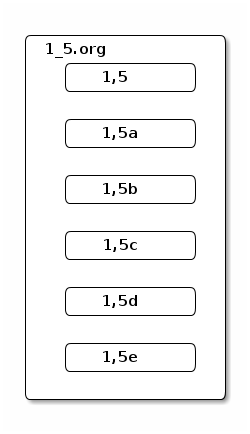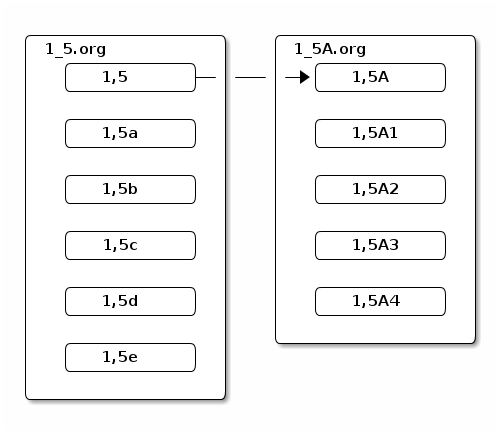Org-Mode based Zettelkasten
Table of Contents
Short Summary
I've engaged myself with Luhmanns method to store knowledge in an elaborated way without creating a knowledge database. Luhmann used slips of paper, stored within wooden boxes called slip boxes or German "Zettelkasten". As I like digital workflows more, I translated his method in order to please my needs. The following is this translation.
Digital Slips, Train of thought and Cross references within org files
The backbone of my slip box method are org-files. An org-file is a text file that contains text written within a markup language called org-mode. The term markup is originated within the printing industry and there marks typographic instructions to the text. These instructions describe, how (e.g. italic or bold) something should look. Within the digital age, there are more things to mark, as links or pictures can be understood also as special kinds of marks. Org-mode as markup language therefore defines what can be marked and how that is marked.
One main part of org-mode is structuring text by outlining it into headings and subheadings with endless nesting capabilities. A heading is a line that starts with one or more stars (*) where the number of stars defines the nesting (see https://orgmode.org/).
Slips
A single slip or a single though within this context is something that will be put under a single heading. Different slips will be put beneath their own heading. It is also possible to define a heading with no text, so using the heading only as structuring element.
Example for a slip with a heading containing text:
* Thought
A thought is a heading ("* heading")
Example for a slip with an empty heading
*
One can leave the heading text empty
The paper slip comes with the property of being restricted within size. It therefore can't hold endless descriptions of thoughts. This restriction helps to formulate ones thoughts short and meaningful. The analog model is written on slips of format ISO216 A6 which will hold around 100 words. If that though can't be written on a single slip, another slip can be attached and together they will make up train of thought.
A digital slip is unrestricted in that sense and therefore harbors the danger of capturing long and dissipated thoughts. Therefore that restriction shall be translated into a rule of thumb: to put ones thoughts just in that many words, a paper slip could also hold easily.
Continuing Slips
The continuation of a slip or of a though into a train of thought(s) is done by adding more headings. Here comes the possibility in handy, to use the headings just as structuring element and without a heading text. Within the analog model, the train of though is hold together by numbering the slips in a continuing way (See figure 1). The first slip of train of thought is numbered with e.g. "1,5" and it's successors will then be numbered as "1,5a", "1,5b", "1,5c", "1,5d" and "1,5e". This can be depicted as a graph where the graphs nodes are the single slips:
![]()
Figure 1: Graph of train of thought # 1,5
A train of thought within the org based slip box is kept together by an org file. Within the example above that would be the file 1_5.org which holds the headings of the slips "1,5", "1,5a", "1,5b", "1,5c", "1,5d" as well as "1,5e". It can be depicted by the following, whereas the little contained boxes are the slips, the outer box is the org file.

Figure 2: Org-File-Structure of train of thought 1,5
Inner branching
To branch of from one part of a slip (e.g. a specific word) into a new thought of train one would mark that point on the slip. That could also be in a different color in order to make the branching clearly visible. If the branch would start of, of the slip "1,5" one could mark the point with the number postfix (e.g. "A") of that new branch. The newly branched train of thought will then contain the slips "1,5A", "1,5A1", "1,5A2", "1,5A3" and "1,5A4".

Figure 3: Graph including the branch 1,5A
The org based slip box will hold the whole branch within a new org file named 1_5A.org. So both trains of thought will life in their separate org files side by side. A link from slip "1,5" onto slip "1,5A" will indicate the connection of the two. That link can be added to the word, one would like to branch of. It must link to the ID of the slip the link is pointing to. Such an ID can be added to every org heading, which represents the slip, by introducing a property drawer with the function org-store-link.
Cross references
A cross reference on a paper slip is denoted by the whole number of the slip the reference goes onto. Usually this is made explicit (as can be seen here) by writing "see also 1,6e". Within the org based slip box, there is no difference between inner branches and cross references, as both will use the same type of link in the same way.
Useful though confusing
A grown slip box will be confusing but that is somewhat the goal of the task. Luhmann describes communication as a process, where each participant is able to surprise the other. Translated into the slip box, this means that the box will start to surprise its user only if the user can't foresee the outcome of consulting it (see Luhmann, 1981). So the slip box needs to be confusing in the sense of unforeseeable but must not be confusing in the sense of unusable.
This requirement can only be fulfilled if (a) there are more slips within the box as the user might oversee and (b) if the slips are well interconnected with each other. It should be possible to navigate from one topic to another only by following the inner references. Therefore the cross references are important. Of course there will be cliques of slips within the graph of the slip network, but unconnected parts should be avoided. This is also true due to the fact, that navigating through the slip box is the task that will generate new insights by revealing connects one did not think about before consulting the box.
Indexes
Sure, it does not help a lot if one must always navigate half of the box in order to get to the requested staring point. Therefore a keyword register to point of interest within the box can be a helpful tool. The keyword register offers shortcuts into the box, so one can start its journey at the right part of the box. This is mandatory while working with paper slips and provides a benefit even in the digital version.
Be sure to not overdo it by registering to many keywords or by adding to many staring points per keyword. The keyword register shall contain only the important entry points. Also the keyword register might not be mistaken with a full-text search. The search can be helpful but one has to keep in mind, that it will yield every source of the search term and therefore the user might still not get the best entry point into the box.
So in the end, there is no rule of what the right amount of keywords and entry points per keyword is. Therefore put into the keyword register as much as necessary but as little as possible.
Separation of notes and slips
On the way of creating a slip box one will most probably do need to note down a lot. For this, also the org files come in handy. But it is important not to confuse the two types of notes, even if they are structurally pretty much similar. Therefore one should store them separately of the slip boxes slips (see Ahrens, 2017, P.32)
One could use e.g. an org file called Notes.org as digital notepad/memo and another one called somewhat Literaturenotes.org for the notes created while reading.
In the process of creating slips from the reading notes, it is easy to write them even within the Literaturenotes.org file. This can also be compared to the paper workflow, where one will have both papers side by side on the desk.
Placing of slips
After creating the slips one will place them within the box. Therefore the created note must just be moved out of the Literaturenotes.org and into an org file of the slip box. If there is no thought of train the slip belongs to, a new org file is created and the slip is moved into it.
Important within this step is to think about possible cross references to already existing trains of thought. Again, only the connected information can be found again within the slip box. So the references are of special importance as they define if a slip is found within the right context within the future.
Sources
- Luhmann, 1981
- Niklas Luhmann, Kommunikation mit Zettelkästen
- English translation: Communicating with Slip Boxes
- Ahrens, 2017
- Sönke Ahrens, Das Zettelkasten Prinzip
- English translation: How to take smart notes
